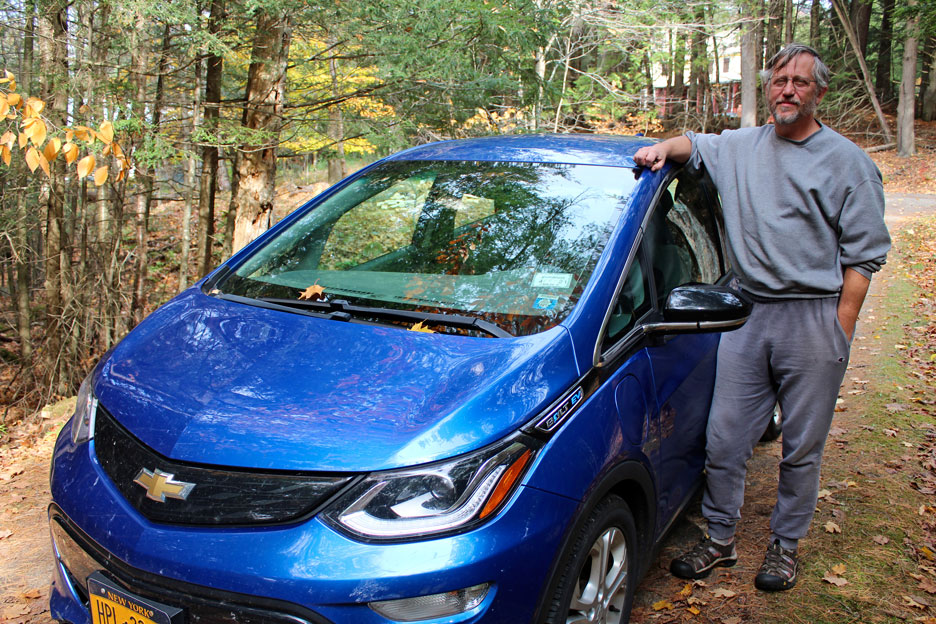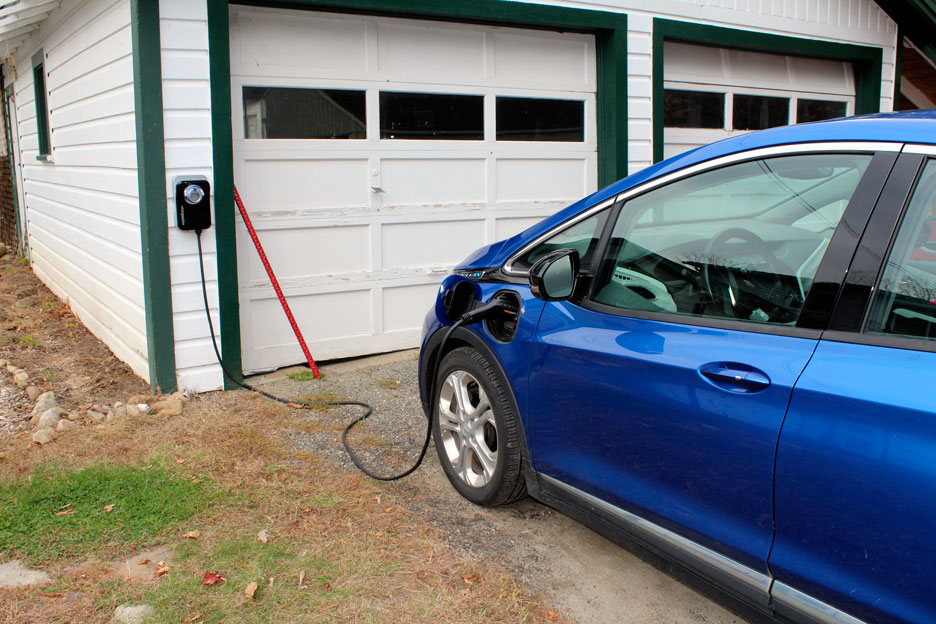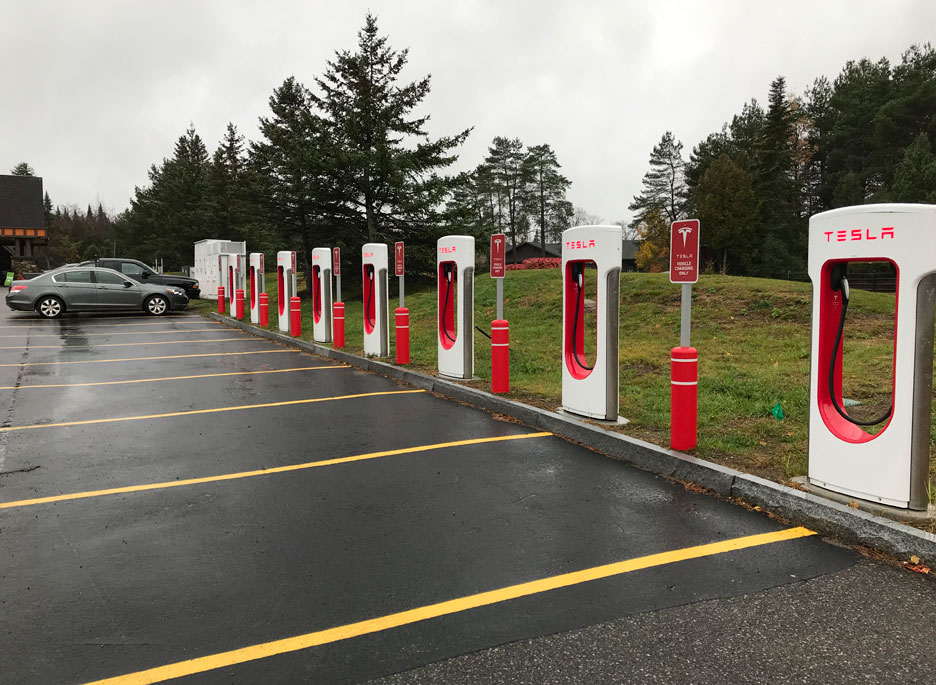ON THE SCENE: Electric car owners love low costs to charge and maintain them
- Provided photo — Naj Wikoff Pete Nelson poses with his electric Chevrolet Bolt at his home in Keene.
- Provided photo — Naj Wikoff Pete and Amy Nelson’s Chevrolet Bolt is plugged in to a charging station on the garage of their home in Keene.
- Provided photo — Naj Wikoff The Price Chopper supermarket parking lot in Lake Placid has many Tesla electric car charging stations.

Provided photo — Naj Wikoff Pete Nelson poses with his electric Chevrolet Bolt at his home in Keene.
CleanTechnica, a clean-tech-focused news and analysis website, and Consumer Reports recently published articles extolling the financial benefits of owning an electric vehicle. In its November issue, Consumer Reports stated that owning a plug-in electric car today will save consumers thousands of dollars compared to owning a gas-powered vehicle.
How significant are the savings? Consumer Reports’ analysis found that owning a Tesla Model 3 would save well over $11,000 over five years of owning Audi’s popular 4A and $18,000 over five years of owning BMW’s top-of-the-line 330i.
CleanTechnica reported three big differentiators for owning an electric vehicle over gasoline powers cars, SUVs and trucks. The first is EV owners spend less than half as much to repair and maintain their vehicles. Second, they spend 60% or less to charge their cars than those who fuel by gasoline. They added that those who charge their EVs at home using a solar-based energy source, on average, use a public plug-in only six times a year; consequently, their energy costs are even far less. The third significant distinction is that EVs hold their value far longer than gasoline-powered cars.
Electric vehicles are not new. In the 1830s, Scotland’s Robert Anderson created an electric-propelled moving vehicle, but it had no practical use as it had no batteries. A few years later, Robert Davidson, also a Scot, built an electric locomotive that could travel 1.5 miles at an average of 4 miles per hour, towing an impressive six tons. This feat so unnerved railway workers who maintained steam engines that they smashed Davidson’s prototype to bits, perceiving it as a threat to their jobs.
With the advent of a rechargeable battery in 1859, various mechanics on both sides of the Atlantic attempted to make electric vehicles. In 1890, William Morrison of Des Moines, Iowa, also of Scottish heritage, applied for a patent for his electric carriage that he showcased in an 1888 parade. His carriage had front-wheel drive and a four-horsepower engine, and reached an outstanding speed of 20 miles per hour. His challenge was it needed recharging every 50 miles; nonetheless, it inspired numerous inventors over the many decades since.

Provided photo — Naj Wikoff Pete and Amy Nelson’s Chevrolet Bolt is plugged in to a charging station on the garage of their home in Keene.
Perhaps hard to believe today, but soon electric vehicles became the most popular modes of personal transport in the world. Indeed, by 1900, a third of all cars on the road were electric, cutting into the horse-drawn carriage trade. Then, as now, their benefits were being cheap, quiet and simple to operate, and they didn’t give off the noxious smells of the early gasoline vehicles and a horse’s droppings. Women loved them.
The first EVs proved to be excellent in urban settings, where the distance driven was never long. Soon, increasing numbers of charging stations came available, but even so, they proved impractical for people who needed to travel for more than a few miles. Their death knell was Henry Ford’s innovation of mass-producing the Model T at prices most Americans could afford, coupled with the emerging oil industry’s desire to do whatever it could to encourage the expansion and use of gasoline-powered engine.
It took the 1970s oil crisis to re-spark interest in the electric car, for all the reasons it was so loved 70 years earlier: quiet, clean and easy to use, coupled with the added benefit of reducing our dependence on imported oil. The challenge remained the same: the distance the car could go on a single charge. Congress passed the Electric and Hybrid Vehicle Research, Development and Demonstration Act of 1976, which authorized the Department of Energy to sponsor research to make EV vehicles practical.
Part of the research focused on hybrids, first developed by Ferdinand Porsche, founder of the beloved sports car company, who in 1898 created the first known gasoline-electric hybrid that he called the P1. Toyota’s Prius, introduced in 1997, became the first mass-produced hybrid. Key to its success was its use of a nickel-metal hydride battery, an outcome of the 1976 Act. The next major step was initiated in 2010 by a new Silicon Valley startup, Tesla Motors, that released a luxury car that could go more than 200 miles on a single charge, beating out major car companies across the world.
“It takes at most two hours to charge my Tesla,” said William Redpath of Keene. “I used to own a (Subaru) Forester. My yearly maintenance costs were at least $8,000 with the Forester. Now they’re much less, and the Tesla’s acceleration is amazing, like a sports car.”

Provided photo — Naj Wikoff The Price Chopper supermarket parking lot in Lake Placid has many Tesla electric car charging stations.
“I love my Chevy Bolt,” said recent owner Debra Whitson of Keene Valley. “I’m going to love it when it’s 20 below and I won’t have to freeze my fingers off pumping gas. It’s super-responsive. It’s got great pickup, very comfortable and super-quiet. It has many nice user interface features and energy use information on the console. I’m enjoying it; it’s an all-around very nice car. I don’t think I’m sacrificing anything in terms of comfort.”
Whitson purchased the car because she cares about protecting the environment and feels that owning an electric vehicle is good for the environment. Pete and Amy Nelson of Keene got their vehicles for the same reason, starting with a Chevy Volt, an electric-gasoline hybrid that Chevrolet has discontinued. They have since purchased a Bolt, which Pete uses for his weekday commute for his teaching job in Ticonderoga. They charge their cars with electricity generated by solar panels on their garage.
“The first thing that attracted me to electric cars was being able to reduce carbon emissions,” said Pete. “We were early adopters of hybrid plug-ins, starting with our Chevy Volt we bought six years ago. In our professions, which includes performing a lot, we’d drive forty to forty-five thousand miles a year — this before COVID — and that’s a lot of carbon emissions. We were uncomfortable with that and wanted to do our part.”
Upon owning an electric car and finding it improving his lifestyle and economics, Pete dove into learning all he could and became active in getting electric charging stations installed in Keene and Keene Valley. EV charging stations are now abundant in Lake Placid, with nearly three dozen public access pumps available (65% providing free power) that include a large bank of Tesla charging ports installed at the Price Chopper supermarket parking lot by property owner Joe Barile.
“Electric cars use a dynamo,” said Pete. “It’s essentially the same electric motor you find in an appliance. It spins. Because it spins, there’s no transmission, no parts to wear out. It spins at variable speeds, all controlled by software. Thus, the ability to drive it and make it do whatever you want is unlike any gas car I’ve ever driven. I never use the brake; I use the “gas” pedal, like on a golf cart, to slow the car down. Add to that, an electric car costs less than a fifth to operate than a gas car. There is virtually no maintenance. If you open the owner’s manual for the Chevy Bolt and look at the recommended maintenance for the first 125,000 miles, it says, ‘If the cabin air filter gets dirty, change it’; that’s it. Compare that to any gas car.”
Pete’s challenge is the months of November through early February, when the days are shortest and often overcast. Then he draws his power from NYSEG at a rate substantially more than people living in Lake Placid and Tupper Lake, with their cheap hydropower deals. While the cost of charging his cars goes up, even so, it remains far less than using gasoline.
“Electric cars are an excellent fit for the Adirondacks,” said Pete.





